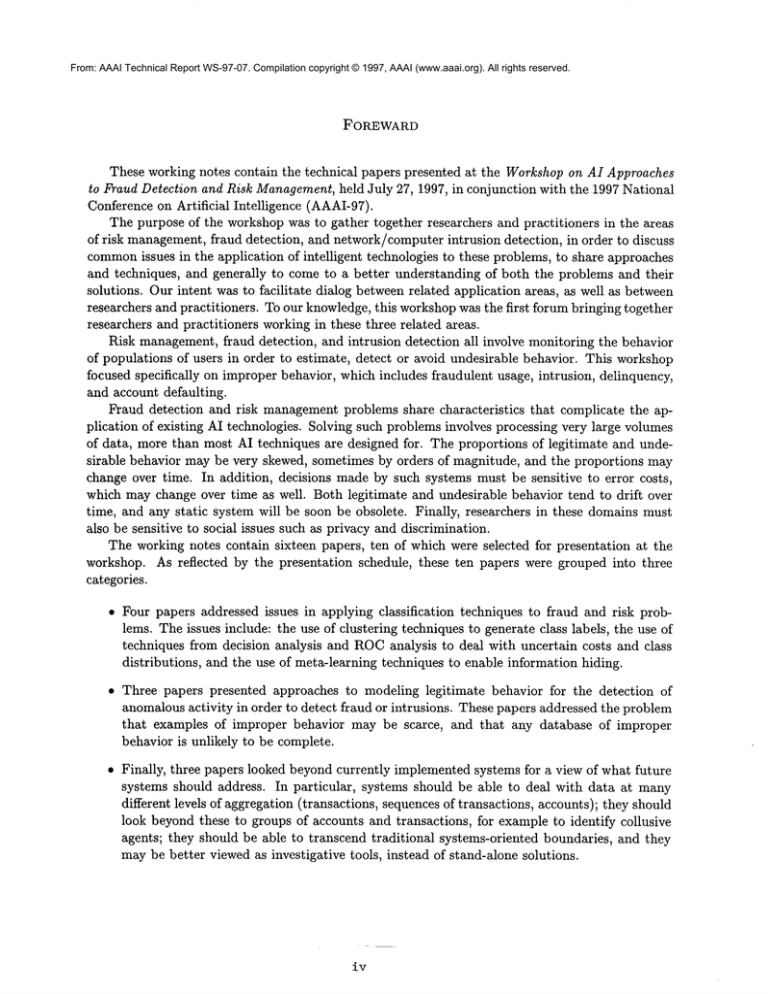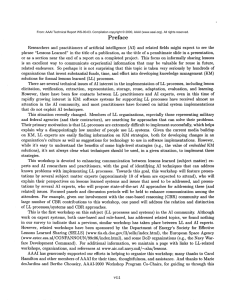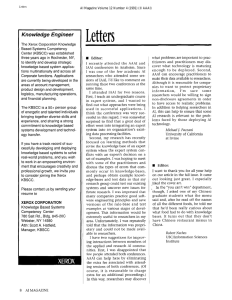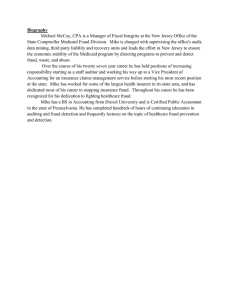
From: AAAI Technical Report WS-97-07. Compilation copyright © 1997, AAAI (www.aaai.org). All rights reserved.
FOREWARD
These working notes contain the technical papers presented at the Workshop on AI Approaches
to Fraud Detection and Risk Management,held July 27, 1997, in conjunction with the 1997 National
Conference on Artificial Intelligence (AAAI-97).
The purpose of the workshop was to gather together researchers and practitioners in the areas
of risk management,fraud detection, and network/computer intrusion detection, in order to discuss
commonissues in the application of intelligent technologies to these problems, to share approaches
and techniques, and generally to come to a better understanding of both the problems and their
solutions. Our intent was to facilitate dialog between related application areas, as well as between
researchers and practitioners. To our knowledge, this workshopwas the first forum bringing together
researchers and practitioners working in these three related areas.
Risk management,fraud detection, and intrusion detection all involve monitoring the behavior
of populations of users in order to estimate, detect or avoid undesirable behavior. This workshop
focused specifically on improper behavior, which includes fraudulent usage, intrusion, delinquency,
and account defaulting.
Fraud detection and risk managementproblems share characteristics
that complicate the application of existing AI technologies. Solving such problems involves processing very large volumes
of data, more than most AI techniques are designed for. The proportions of legitimate and undesirable behavior may be very skewed, sometimes by orders of magnitude, and the proportions may
change over time. In addition, decisions madeby such systems must be sensitive to error costs,
which may change over time as well. Both legitimate and undesirable behavior tend to drift over
time, and any static system will be soon be obsolete. Finally, researchers in these domains must
also be sensitive to social issues such as privacy and discrimination.
The working notes contain sixteen papers, ten of which were selected for presentation at the
workshop. As reflected by the presentation schedule, these ten papers were grouped into three
categories.
Four papers addressed issues in applying classification techniques to fraud and risk problems. The issues include: the use of clustering techniques to generate class labels, the use of
techniques from decision analysis and ROCanalysis to deal with uncertain costs and class
distributions, and the use of meta-learning techniques to enable information hiding.
Three papers presented approaches to modeling legitimate behavior for the detection of
anomalousactivity in order to detect fraud or intrusions. These papers addressed the problem
that examples of improper behavior may be scarce, and that any database of improper
behavior is unlikely to be complete.
Finally, three papers looked beyond currently implemented systems for a view of what future
systems should address. In particular, systems should be able to deal with data at many
different levels of aggregation (transactions, sequences of transactions, accounts); they should
look beyond these to groups of accounts and transactions, for example to identify collusive
agents; they should be able to transcend traditional systems-oriented boundaries, and they
maybe better viewed as investigative tools, instead of stand-alone solutions.
iv
Our hope was for the workshop to facilitate
interaction between researchers and practitioners, focus on the commonalitiesamongfields previously treated in isolation, and cross-fertilization
amongthe fields. Wethank the authors and attendees for their efforts and enthusiasm in making
this possible. Weare indebted to the AAAIorganization for organizational and funding assistance,
and for publishing these working notes; to Ray Mooney, Chair of the AAAI-97WorkshopCommittee; to Mary Beth Jensen, AAAIworkshop co-ordinator; and to our anonymousworkshop-proposal
reviewers for their suggestions and encouragement.
Tom Fawcett, Ira Haimowitz, Foster Provost and Salvatore Stol]o
V




